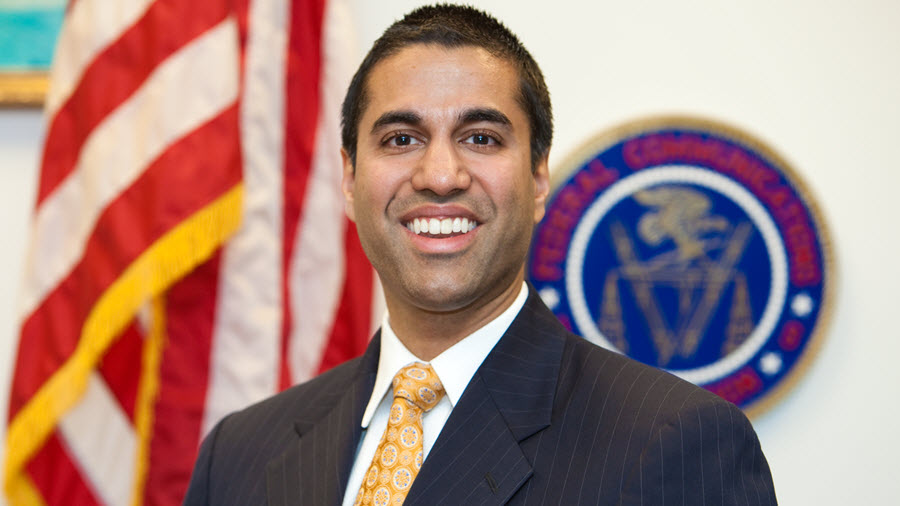Pai Pushes TV White Spaces Rule for Rural Broadband Delivery
The long-simmering proposal to use broadcast "white spaces" for rural broadband delivery using TV channels 2 through 35 will be on the Federal Communications Commission's next meeting agenda, opening a new way to supply a "critical role in providing broadband services to rural and underserved areas,” according to FCC chairman Ajit Pai, who unveiled the plan Wednesday (Feb. 5).
"The FCC has taken steps to enable the use of white spaces over the years, and this new proposal would further help bridge the digital divide while protecting TV stations," Pai said in a statement that unveiled his plan to introduce a Notice of Proposed Rulemaking at the FCC's Feb. 28 meeting.

The National Association of Broadcasters, which has been skeptical of white spaces plans since they were first proposed, quickly offered a conciliatory response.
“NAB appreciates the consensus-based approach the FCC is taking in this proceeding," said NAB executive VP of communications Dennis Wharton. "We look forward to working with the Commission and other stakeholders to develop final rules that will allow more flexibility for rural white spaces operations while protecting broadcasters.”
Pai's new proposal comes almost one year after the FCC put its white spaces agenda on hold while it encouraged Microsoft and broadcasters to hash out a spectrum sharing agreement for wireless broadband. At that time, Pai (during Congressional testimony) cited the “tricky” technical and policy matters the agency needs to address even as Microsoft and TV stations try to find a middle ground on the band’s use.
Microsoft, which originally proposed the rural broadband white spaces plan in 2017 had no immediate comment. When it first revealed its white spaces concept, the company cited a July 4, 2022, goal for the Microsoft plan to "close the rural broadband gap." At that time, Microsoft contended that a nationwide plan "could cost less than $12 billion" and be rolled out within five years. It cited analyses indicating that 80% of people who live in sparsely populated U.S. areas would benefit from such white spaces service via broadcast airwaves.
Pai's Plan Envisions Greater Reach in Rural Regions
The smarter way to stay on top of the multichannel video marketplace. Sign up below.
Pai said his proposal will "increase the minimum required separation distances for white space devices operating at higher power" to protect other authorized services from interference. His plan calls for permitting higher transmit power and higher antennas for fixed white space devices in rural areas.
Such changes would allow white space devices to reach users at greater distances, enabling improved broadband coverage. Higher power would also enable signals to better penetrate foliage, buildings, and other obstacles. Pai's plan would also permit higher power mobile operations within geo-fenced areas.
The chairman pointed out that the NPRM envisions introduction of broadband technology that would facilitate the development of "innovative narrowband Internet of Things-based services."
Last month Microsoft told the FCC that wireless internet providers have been able to boost their throughput tenfold using TV white spaces. At a meeting between FCC and Microsoft executives, the company urged the Commission to move ahead with plans for a rulemaking that had been lingering since May 2019.
Related: Microsoft Pushes FCC To Act on White Spaces Petition
Microsoft and NAB have reportedly come to an agreement on four of the five proposals in Microsoft's plan, but broadcasters still oppose a plan to authorize higher power operations on the first-adjacent channel to broadcasters licensed service.
In 2018 at congressional reauthorization hearings, Pai vowed that the FCC would be aggressive about freeing up TV band white spaces for rural broadband "if the facts warrant and the law allows it."
Most commissioners concurred at that time, although commissioner Michael O'Rielly said he would continue his support of unlicensed white spaces "but not at the expense of full-power broadcast channels."
Contributor Gary Arlen is known for his insights into the convergence of media, telecom, content and technology. Gary was founder/editor/publisher of Interactivity Report, TeleServices Report and other influential newsletters; he was the longtime “curmudgeon” columnist for Multichannel News as well as a regular contributor to AdMap, Washington Technology and Telecommunications Reports. He writes regularly about trends and media/marketing for the Consumer Technology Association's i3 magazine plus several blogs. Gary has taught media-focused courses on the adjunct faculties at George Mason University and American University and has guest-lectured at MIT, Harvard, UCLA, University of Southern California and Northwestern University and at countless media, marketing and technology industry events. As President of Arlen Communications LLC, he has provided analyses about the development of applications and services for entertainment, marketing and e-commerce.

